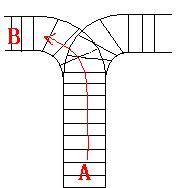本次周赛的一道题,当时脑子抽了,愣是WA,下来看了看以前的代码,又是参数写错了,艹
题目链接:http://acm.hdu.edu.cn/showproblem.php?pid=1022
Train Problem I
Time Limit: 2000/1000 MS (Java/Others) Memory Limit: 65536/32768 K (Java/Others)
Total Submission(s): 20786 Accepted Submission(s): 7825
Problem Description
As the new term comes, the Ignatius Train Station is very busy nowadays. A lot of student want to get back to school by train(because the trains in the Ignatius Train Station is the fastest all over the world ^v^). But here comes a problem, there is only one railway where all the trains stop. So all the trains come in from one side and get out from the other side. For this problem, if train A gets into the railway first, and then train B gets into the railway before train A leaves, train A can't leave until train B leaves. The pictures below figure out the problem. Now the problem for you is, there are at most 9 trains in the station, all the trains has an ID(numbered from 1 to n), the trains get into the railway in an order O1, your task is to determine whether the trains can get out in an order O2.






Input
The input contains several test cases. Each test case consists of an integer, the number of trains, and two strings, the order of the trains come in:O1, and the order of the trains leave:O2. The input is terminated by the end of file. More details in the Sample Input.
Output
The output contains a string "No." if you can't exchange O2 to O1, or you should output a line contains "Yes.", and then output your way in exchanging the order(you should output "in" for a train getting into the railway, and "out" for a train getting out of the railway). Print a line contains "FINISH" after each test case. More details in the Sample Output.
Sample Input
3 123 321 3 123 312
Sample Output
Yes. in in in out out out FINISH No. FINISH
#include <stdio.h>
short mark[15];//用于标记每辆车进站出站的数组 1为 in 0 为out
char a[15];//进站时火车的队列
char b[15];//出站时火车的队列
char zhan[15];//栈
int top;//栈顶指针
int main()
{
int n, i, k, p;
while(~scanf("%d",&n))
{
scanf("%s%s",a,b);
for( top = 1,p = k = i = 0; i < n; i++)
{
zhan[top++] = a[i]; //先进栈
mark[k++] = 1;
while(top > 1 && zhan[top - 1] == b[p]) //栈顶元素与 b 首元素相等 即出栈
{
mark[k++] = 0;
top--;
p++;
}
}
if(p == n)
{
printf("Yes.\n");
for( i = 0; i < k; i++)
{
if(mark[i])printf("in\n");
else printf("out\n");
}
}else {
printf("No.\n");
}
printf("FINISH\n");
}
return 0;
}
运行结果:






















 361
361











 被折叠的 条评论
为什么被折叠?
被折叠的 条评论
为什么被折叠?








